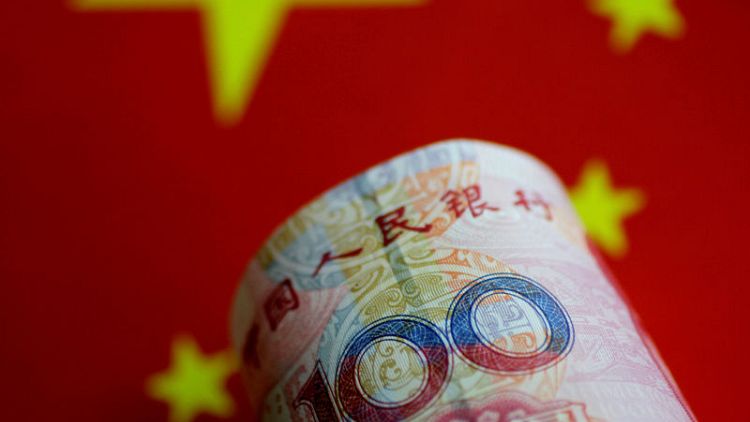By Kevin Yao
BEIJING (Reuters) - China is comfortable with a weakening yuan, intervening only to prevent any rapid and destabilising declines or to restore market confidence, as the economy loses momentum and faces further risks from a heated trade dispute with the United States, policy insiders said.
On Tuesday, as stocks sank and the yuan fell through a key psychological level of 6.7 on the dollar, traders said state-owned banks, which sometimes act on behalf of the central bank, made efforts to prop up the currency.
All the same, authorities are confident they won't have to make heavy use of the official foreign exchange reserves to defend the yuan like in 2015 when stocks and the currency went into a tail spin as capital outflows accelerated, three sources who are familiar with policymakers' thinking told Reuters before the latest intervention.
After the lessons of 2015, Beijing considers it has the policies in place to prevent any destabilising sell-off in the yuan, the sources said.
While the intervention underscored Beijing's desire to inject confidence in markets that have been roiled by the trade war fears, the sources say policymakers would tolerate a weaker yuan to help cushion a slowing economy and take some of the sting out of Washington's proposed tariffs on its exports to the United States.
“Policymakers believe some yuan depreciation is okay, but they don’t want to see it falling below 6.9. Appropriate currency depreciation is needed given that the economy faces downward pressure," one policy insider said.
A second policy source echoed those views: “there is no big problem with the yuan depreciation. It could be beneficial as the economy is slowing. We are able to control capital outflows. There is no need for aggressive intervention.”
The PBOC has yet to respond to Reuters' request for comment.
The yuan saw its worst month on record in June, falling about 3.3 percent against the dollar, drawing comparisons with the 2015 episode of sharp yuan depreciation which forced the People's Bank of China (PBOC) to spend more than $800 billion to slow it down. The yuan bounced sharply on Wednesday, a day after the central bank soothed nervous markets.
According to the policy insiders, it is unlikely China will be forced into large-scale intervention. Worries of destabilising outflows are being partly offset by the capital controls China has introduced to arrest the previous slide in the yuan and restore confidence in its financial assets.
The sources are involved in internal policy discussions but are not part of the final decision-making process. They spoke on condition on anonymity.
ECONOMY BETTER EQUIPPED
Besides the capital outflow risks, a sharp weakening in the yuan may pose financing problems for companies exposed to dollar-denominated debt.
Beijing is also expected to make use of other tools it has finessed since 2015, such as the "counter-cyclical factor" it introduced in May last year to the formula it uses to determine the mid-point reference rate for the yuan’s exchange rate against the dollar each day. That factor was designed to curb speculation and volatility in the yuan.
"The authorities have become more experienced in managing the currency," said a third source who advises the government. He expects some form of intervention in the 6.7-6.8 area.
"Currently, the pressure is not as big as in 2015 … if the depreciation trend continues like this, they could take some measures, including reviving the counter-cyclical factor, rather than heavy spending of foreign exchange reserves."
Also, a years-long government-led crackdown on financial risks has meant China is better equipped to handle market ructions than in 2015 when the turmoil in stocks and the yuan currency was partly blamed on bungled rescue attempts by the authorities.
Most measures taken since late 2015 to tighten controls on money moving out of the country, including closer scrutiny of outbound investments, large overseas money transfers and individual foreign exchange purchases remain in place.
Earlier this year, China eased the tap a bit by granting qualified domestic financial institutions fresh quotas to buy overseas stocks and bonds, but the yuan depreciation has not come on the back of heavy outflows like two years ago.
"They can reintroduce the counter-cyclical factor, they can tighten capital controls, in the end they can even use a small amount of their reserves … but this time is different because there is already a strict regulation on capital outflows," said Mahamoud Islam, Hong Kong-based senior APAC economist at Euler Hermes.
NO DELIBERATE YUAN-WEAKENING
Some policy advisers said authorities are also likely to use subtle measures, such as higher-than-expected midpoint yuan fixings to sound discomfort with the pace or direction of the moves and limit any large-scale direct intervention.The message that the recent yuan weakening is not deliberately driven by China resonates with many economists and investors and Tuesday's market action reinforced it.
"I don't believe they are using the yuan as a tool in negotiations with the U.S.," said Jean-Charles Sambor, deputy head of emerging market debt at BNP Paribas Asset Management in London.
"They are less interventionist than in the past, but I do think around 6.7 they may be intervening to keep confidence in the yuan and make sure they are not facing massive outflows."
(Additional reporting and Writing by Marius Zaharia; Editing by Shri Navaratnam)



